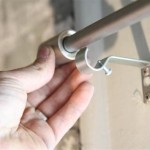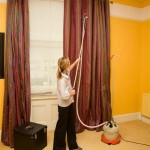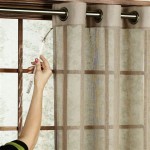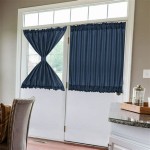Curtain Rods That Go Around Corners: A Comprehensive Guide
Curtain rods that navigate corners offer a versatile solution for window treatments in spaces with unconventional layouts. These specialized rods allow curtains to flow seamlessly around corners, creating a cohesive and aesthetically pleasing look. Unlike traditional straight rods, corner curtain rods overcome the challenge of abrupt breaks in fabric, providing better light control, enhanced privacy, and an improved overall design aesthetic.
The demand for corner curtain rods has grown alongside the increasing popularity of open-concept living spaces and homes with unique architectural features. These rods address the functional need for uninterrupted window coverage while simultaneously enhancing the visual appeal of a room. The selection of a suitable corner curtain rod involves considering various factors, including the rod's material, design, weight capacity, and installation requirements.
Types of Corner Curtain Rods
Several types of corner curtain rods are available, each designed to meet specific needs and aesthetic preferences. Understanding the differences between these types is crucial for selecting the most appropriate option for a given space.
1. Elbow Connector Rods: This is one of the most common types of corner curtain rods. It consists of straight rod sections connected by an elbow joint that allows for a 90-degree turn. Elbow connectors are typically adjustable, permitting slight variations in the angle to accommodate corners that are not perfectly square. These rods are generally made of metal, such as steel or aluminum, and are available in various finishes to match different decor styles. Installation usually involves mounting brackets on the wall or ceiling to support the rod sections.
2. Flexible Curtain Rods: These rods are made from a pliable material that can be bent to conform to the shape of the corner. Flexible rods are particularly useful for curved walls or corners that are not strictly 90 degrees. They are often made of PVC or a similar polymer and can be easily cut to the desired length. While flexible rods are relatively easy to install, they may not be as sturdy as metal rods and may require additional support brackets to prevent sagging, especially when used with heavy curtains.
3. Traverse Curtain Rods with Corner Connectors: Traverse rods are designed for curtains that open and close using a draw cord or wand. Corner connectors for traverse rods allow the curtains to glide smoothly around the corner without getting caught. These connectors typically feature a swivel mechanism that facilitates the movement of the curtain carriers. Traverse rods are a good option for those who want the convenience of easy curtain operation, but they are generally more complex to install than standard corner curtain rods.
4. Bay Window Curtain Rods: Although technically designed for bay windows, these rods can be adapted for use in standard corners. Bay window rods typically consist of multiple adjustable sections that can be configured to fit various angles. They are usually made of metal and are available in a range of styles, from traditional to contemporary. Bay window rods are a versatile option for creating a custom look, but they may require more careful planning and installation to ensure a secure and aesthetically pleasing result.
5. Custom-Made Corner Curtain Rods: For unique or complex corner configurations, a custom-made curtain rod may be the best solution. Custom rods can be fabricated to precise specifications, ensuring a perfect fit and optimal performance. They can be made from a variety of materials, including metal, wood, and composite materials, and can be designed to accommodate different curtain weights and styles. While custom rods are typically more expensive than off-the-shelf options, they offer unparalleled flexibility and design control.
Factors to Consider When Choosing a Corner Curtain Rod
Selecting the right corner curtain rod involves considering several important factors to ensure that it meets the specific needs of the space and the desired aesthetic. Neglecting these factors can lead to disappointment and the need for costly replacements.
1. Corner Angle and Shape: The angle of the corner is a critical consideration. Standard 90-degree elbow connectors are suitable for square corners, but other types of connectors may be needed for obtuse or acute angles. For curved walls or corners, a flexible curtain rod is often the best option. It is essential to accurately measure the angle and shape of the corner before purchasing a rod to ensure a proper fit. Using a protractor or angle finder can help determine the exact angle of the corner.
2. Curtain Weight and Fabric: The weight of the curtains will influence the type of rod and the number of support brackets needed. Heavy curtains, such as those made of velvet or thick brocade, require sturdier rods and more robust support brackets to prevent sagging. Lighter curtains, such as sheer or linen fabrics, can be supported by lighter-duty rods and fewer brackets. The fabric's draping characteristics should also be considered. Some fabrics drape better on curved or flexible rods than others. Testing a small sample of the fabric on the chosen rod type can help ensure a satisfactory result.
3. Material and Finish: The material and finish of the curtain rod should complement the overall decor of the room. Metal rods are available in various finishes, such as brushed nickel, oil-rubbed bronze, and matte black, while wooden rods can be stained or painted to match existing woodwork. The material should also be durable and resistant to corrosion, especially in damp environments like bathrooms or kitchens. The finish should be applied evenly and be resistant to chipping or fading.
4. Installation Requirements: The complexity of the installation process should be considered, especially for those who plan to install the rod themselves. Some corner curtain rods are relatively easy to install, while others require more specialized tools and skills. It is important to read the installation instructions carefully and to have all necessary tools and materials on hand before starting the project. If unsure, seeking professional installation services is advised.
5. Style and Aesthetics: The style of the curtain rod should align with the overall design aesthetic of the room. Simple, minimalist rods are suitable for modern or contemporary spaces, while ornate, decorative rods are better suited for more traditional or formal settings. The rod's design should also complement the style of the curtains. For example, a simple rod is a good choice for patterned curtains, while a decorative rod can add visual interest to plain curtains. The overall goal is to create a cohesive and harmonious look that enhances the room's decor.
Installation Tips for Corner Curtain Rods
Proper installation is crucial for ensuring that a corner curtain rod functions correctly and looks aesthetically pleasing. Following these tips can help achieve a successful installation:
1. Accurate Measurements: Before starting the installation, take accurate measurements of the window and the corner. Measure the distance from the window to the corner and the length of the rod sections needed. Use a level to ensure that the rod is installed straight and even. Precise measurements will prevent gaps and ensure a professional-looking result.
2. Proper Bracket Placement: The placement of the support brackets is critical for the stability of the curtain rod. Brackets should be spaced evenly along the rod, with additional brackets placed near the corners to provide extra support. Use a stud finder to locate wall studs and attach the brackets to the studs whenever possible. If studs are not available, use drywall anchors to secure the brackets to the wall. Ensure that the brackets are aligned properly to prevent the rod from sagging or becoming unstable.
3. Secure Fastening: Use appropriate screws and anchors to fasten the brackets to the wall. The size and type of screws and anchors will depend on the type of wall material and the weight of the curtains. Ensure that the screws are driven in securely and that the anchors are properly seated in the wall. Loose or improperly installed fasteners can lead to the rod becoming unstable or even falling down.
4. Leveling and Alignment: Use a level to ensure that the curtain rod is installed straight and even. Check the alignment of the rod sections and the corner connectors. Make any necessary adjustments to ensure that the rod is perfectly level and aligned. A level installation will not only look better but also ensure that the curtains hang properly.
5. Testing the Stability: Once the installation is complete, test the stability of the curtain rod by gently pulling on it. Ensure that the brackets are securely fastened to the wall and that the rod does not wobble or sag. Hang the curtains on the rod and check that they move smoothly and freely around the corner. If any issues are detected, make the necessary adjustments to ensure that the rod is stable and functional.
By carefully considering the type of corner curtain rod, the relevant factors influencing selection, and following these installation tips, individuals can successfully install corner curtain rods that enhance the functionality and aesthetics of their spaces. These rods provide a practical and visually appealing solution for addressing the challenges posed by corners in window treatments.

Rod Desyne 13 16 Dia Adjustable 120 To 170 Single Corner Window Curtain In Black With Fortune Finials

Drapery Rod Corner Connector For Classic Round Rods Bay Windows

How To Hang Curtain Rods In A Corner Young House Love

Rod Desyne Naomi 13 16 Inch Corner Window Curtain

How To Dress Difficult Windows Curtain Poles For Corner Bay

Drapery Rod Corner Connector For Classic Round Rods Bay Windows

Domovina Gleam 13 16 Corner Window Single Curtain Rod Color Black Size 48 84

1 Dia Adjustable 28 To 48 Blackout Corner Curtain Rod In Black Wal Com

How To Hang Curtain Rods In A Corner Young House Love

Around The Corner Curtain Rod
See Also








